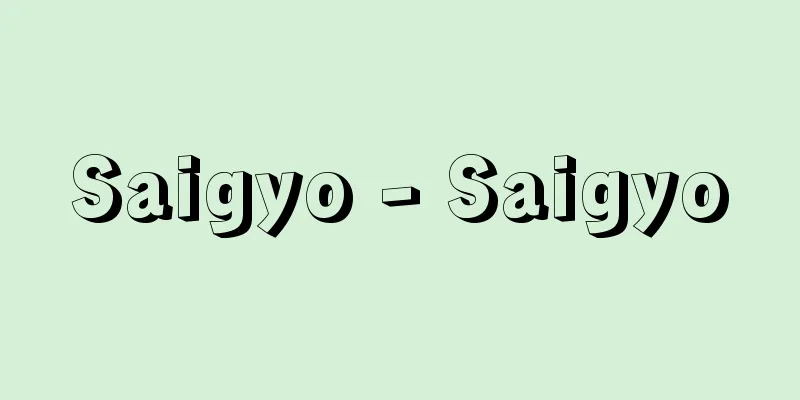Saigyo - Saigyo

|
A poet of the late Heian period. Son of Saemon-no-jo Sato Yasukiyo of the Fujinari line of the Fujiwara clan. His mother was the daughter of Kenmotsu Minamoto Kiyotsune. His Buddhist name was En-i. He was called Daihobo or Daihonbo. One of the ancestors of the Sato family was Tawara Touta Hidesato, and they are also related to the Oshu Fujiwara clan. For generations, the family was a brave warrior, having served as a military officer in Rokuefu and as a Kebiishi. His maternal grandfather Kiyotsune was also an elegant lower-ranking official well versed in Imayo Zougei and Kemari. Saigyo's real name was Yoshikiyo (or Norikiyo), and he became a vassal of Tokudaiji Saneyoshi, and also served Emperor Toba as a samurai in the Shimokita region, with the rank of Hyoe-no-jo, before becoming a monk in 1140 (Hōen 6) at the age of 23. Fujiwara no Yorinaga's diary, Taiki, states that he became a monk as a result of his religious desire, but legends arose early on, such as that he felt the impermanence of life after the sudden death of a close relative, or that it was the result of a tragic love affair, and in modern times, one theory has been put forward that he became a monk after witnessing the political situation in which Taikenmon'in and Emperor Sutoku, whom he had served closely, were marginalized, but this is not clear. A series of love poems such as "Is the moon lamenting something? Is it my tears that are so far away?" suggests that he had a passionate love affair, but it is certain that he had a wife and children before he became a monk. After he became a monk, he retreated to the depths of Saga and Kurama, and also went down to Ise, but later he began living as a saint based in Koyasan. He converted to Shingon Buddhism and trained as a mountain ascetic at Omine in Yoshino, but he did not receive a priest's ordination and lived his life as a shonin. Along with Kunin and Nishiju (Minamoto Suemasa), who later accompanied him, he had been familiar with waka poetry even before he became a monk, and thereafter he devoted himself to composing poetry; it appears that his faith and poetry were the support of his life, which consisted of living in hermitages and on pilgrimages. However, he had relatively few connections with poets in the capital at poetry contests and the like, and was close to a limited number of people, such as the ladies-in-waiting, such as Taikenmon'in Horikawa and Josaimon'in Hyoe, and people around them, as well as the children of Tango no Kami Fujiwara no Tametada, such as Jakunen, Jakucho, and Jakuzen, known as the Tokiwa Sanjaku, and Tametada's son-in-law, Fujiwara no Shunzei. As one of the monks of Koyasan, he also visited the home of Taira no Tadamori, and seems to have had an affinity for the Taira clan. In his 30s, he was fascinated by the poetry of Michinoku, and following in the footsteps of Fujiwara no Sanekata and Noin, he attempted his first journey into the depths of Michinoku. Also, in his mid-30s, one of his poems was included in the Shika Wakashu as an anonymous work. In his early fifties, during the Nin'an era (1166-69), he made a pilgrimage to Chugoku and Shikoku to visit the tomb of Emperor Sutoku in Sanuki (Kagawa Prefecture) and to the ruins of Kobo Daishi. In 1172 (Joan 2), he participated in the memorial service for a thousand monks organized by Taira no Kiyomori, and in 1177 (Jisho 1), he was involved in the relocation of Rengejoin Temple at Mount Koya. In his early sixties, during the Jisho era (1177-81), he left Mount Koya, where he had been living for a long time, and moved to the vicinity of Futamigaura in Ise. It is believed that he taught waka poetry to the priests of Ise Grand Shrine while living in a hermitage there. In 1186 (Bun'ei 2), he solicited 100 poems from Fujiwara Teika, Fujiwara Ietaka, Jakuren and others for the Daijingu Horaku (a Buddhist memorial service held at the Grand Shrine of Ise), and, as promised by Shunjobo Chogen, he once again traveled to Mutsu to solicit gold dust for the reconstruction of the Great Buddha. On the way, he met Minamoto no Yoritomo in Kamakura and spent the night talking with him. During this journey to the eastern provinces, he wrote a poem that is considered to be a self-praise poem: "Fuji disappears into the smoky sky, blowing in the wind, my thoughts disappearing, not knowing where they will go." It was at this time that he also composed the poem, "I thought that when I grew old, I would cross over again, but my life was such that it was Saya no Nakayama." When he returned from Mutsu, he first asked Shunzei to add his signature to his own poetry contest, "Mimosusogawa Poetry Contest," and then, a little later, Teika added his signature to create "Miyagawa Poetry Contest." These were dedicated to the Inner Shrine and Outer Shrine of Ise, but he fell ill at Hirokawadera Temple in Kawachi (Kanan Town, Minamikawachi County, Osaka Prefecture), and passed away there on February 16, 1279, in accordance with his long-held wish: "I wish to die in spring beneath the blossoms, when the full moon shines in Kisaragi." In the year 73. The Shin Kokin Wakashu, compiled after his death, contains 94 of his poems, the largest number of any poet in history, and had a profound influence on later generations of poets, including Jien, Teika, and Emperor Gotoba. Legends were born from his life early on, and it seems that the illustrated "Saigyo Monogatari" was written around the middle of the Kamakura period. He was also credited with being the editor of the tale collection "Senjusho." Many parts of the life of Saigyo, the wandering poet admired by Basho and Meiji poets, are based on these legends and tales. In addition to his family anthologies "Sankashū" and "Kikigakishū," there is also "Saigyo Shonin Danshō," a book of poetry theory transcribed by his disciple Ren'a (Arakida Mitsuyoshi), and "Letter to Lord Teika," a message sent when he requested a seal for the "Miyakawa Utaawase" poetry contest. [Jun Kubota] "A Study of the Intellectual History of Saigyo" by Tokuei Mezaki (1978, Yoshikawa Kobunkan)" ▽ "The Complete Works of Saigyo, edited by Jun Kubota, 1 volume (1982, Japan Classical Literature Association) " ▽ "Poets of the Court 8: Saigyo" by Tamotsu Ariyoshi (1985, Shueisha) [References] | | |<Upper verse> Lament, the moon, I think of something <Lower verse> Here comes my tears, I wonder Nageke tote tsuki ya wa mono o mo omo ha suru Kakochi ga ho naru waga nami na ka Fixed characters (fixed characters): Characters (sounds) that specify a poem / Nageke Saigyo (Saigyo Hoshi) Hishikawa Moronobu illustration [and others] Ogura Hyakunin Isshu 1680 (Enpo 8) National Diet Library possession Ogura Hyakunin Isshu (86) Poet/Saigyo (Saigyo… The scene where Saigyo shaves his head and becomes a monk. Volume 1 (copy held at the National Diet Library ) The Tale of Saigyo Source: Shogakukan Encyclopedia Nipponica About Encyclopedia Nipponica Information | Legend |
|
平安後期の歌人。藤原氏藤成(ふじなり)流の左衛門尉(さえもんのじょう)佐藤康清(やすきよ)の子。母は監物(けんもつ)源清経女(きよつねのむすめ)。法名は円位。大宝坊また大本坊と号した。佐藤家の先祖には俵藤太秀郷(たわらとうたひでさと)がおり、奥州藤原氏とも縁続きである。代々六衛府(りくえふ)の武官で検非違使(けびいし)などを勤める武勇の家であった。また、母方の祖父清経は今様雑芸(いまようぞうげい)や蹴鞠(けまり)に通じている風流な下級官人であったらしい。西行は俗名を義清(のりきよ)(憲清とも)といい、徳大寺実能(さねよし)の家人(けにん)となり、また下北面(げほくめん)の武士として鳥羽院(とばいん)に仕え、兵衛尉(ひょうえのじょう)となったが、1140年(保延6)23歳で出家した。藤原頼長(よりなが)の日記『台記(たいき)』に道心による遁世(とんせい)であるというが、早くから近親者の急死にあって無常を感じたためとか、悲恋の結果であるなどの伝説が生じ、近代には、親しく仕えた待賢門院(たいけんもんいん)や崇徳院(すとくいん)が疎外される政治状況を目のあたりにして出家したのかという説も唱えられているが、明らかではない。「嘆けとて月やは物を思はするかこちがほなるわが涙かな」など一連の恋歌は激しい恋愛体験もあったらしいことを思わせるが、出家以前妻子がいたことは確かであろうと考えられる 30代前後に、陸奥(みちのく)の歌枕(うたまくら)にあこがれ、藤原実方(さねかた)や能因(のういん)の足跡を慕って、最初の陸奥行脚を試みた。また30代のなかばごろ、『詞花(しか)和歌集』にその作品1首がよみ人しらずとしてとられている。 50代の初め、仁安(にんあん)年間(1166~69)、讃岐(さぬき)(香川県)の崇徳院の墓陵参拝と弘法(こうぼう)大師の遺跡巡礼を目的として、中国、四国へ行脚した。1172年(承安2)には平清盛(きよもり)主催の千僧供養に参加し、1177年(治承1)には高野山の蓮華乗院(れんげじょういん)の移築にかかわっている。60代の初め、治承(じしょう)年間(1177~81)に、長らく生活の本拠であった高野山を離れて、伊勢の二見浦(ふたみがうら)の近くに移住した。同地では草庵生活のかたわら伊勢神宮の神官たちに和歌を教えていたと考えられる。1186年(文治2)、大神宮法楽のため藤原定家(ていか)、同家隆(いえたか)、寂蓮(じゃくれん)らに百首歌(ひゃくしゅうた)を勧進し、また俊乗房重源(しゅんじょうぼうちょうげん)との約束によって、大仏再建の砂金勧進のために再度陸奥に下向した。途中鎌倉では源頼朝(よりとも)と会って、一夜を語り明かしている。この東国への旅で自讃(じさん)歌とされる「風になびく富士の煙の空に消えて行方も知らぬわが思ひかな」の歌を得た。「年たけてまた越ゆべしと思ひきや命なりけり佐夜(さや)の中山」の詠もこのときのものである。陸奥から戻ったころ、まず俊成に加判を依頼した自歌合『御裳濯河(みもすそがわ)歌合』が、やや遅れて定家が加判した『宮河(みやがわ)歌合』が成り、これを伊勢の内宮(ないくう)・外宮(げくう)に奉納したが、自身は河内(かわち)の弘川寺(ひろかわでら)(大阪府南河内(みなみかわち)郡河南町)で病み、文治(ぶんじ)6年2月16日、「願はくは花の下(した)にて春死なむそのきさらぎの望月(もちづき)の頃(ころ)」というかねての願いどおり、同地に入滅した。年73。その没後撰(えら)ばれた『新古今(しんこきん)和歌集』には集中最多数の94首がとられ、慈円(じえん)、定家や後鳥羽院(ごとばいん)ら、後の世代の歌人に深い影響を及ぼした。 その生涯は早くから伝説を生じ、鎌倉中期ごろには絵を伴った『西行物語』が書かれたらしい。また、説話集『撰集抄(せんじゅうしょう)』の編者に仮託された。芭蕉(ばしょう)や明治の詩人たちが憧憬(しょうけい)した漂泊の歌人西行の生涯はこれらの伝説や説話に基づく部分も少なくない。家集『山家集(さんかしゅう)』『聞書(ききがき)集』などのほか、弟子蓮阿(れんあ)(荒木田満良(みつよし))の聞き書きした歌論書『西行上人(しょうにん)談抄』、『宮河歌合』への加判を求めた際の消息文である『定家卿(きょう)に送る文(ふみ)』がある。 [久保田淳] 『目崎徳衛著『西行の思想史的研究』(1978・吉川弘文館)』▽『久保田淳編『西行全集』全1巻(1982・日本古典文学会)』▽『有吉保著『王朝の歌人8 西行』(1985・集英社)』 [参照項目] | | |〈上の句〉嘆けとて 月やは物を 思はする 〈下の句〉かこちがほなる わが涙かな なげけとてつきやはものをおもはする かこちがほなるわがなみだかな定まり字(決まり字):歌を特定する字(音)/なげけ西行(西行法師)菱川師宣画[他]『小倉百人一首』 1680年(延宝8)国立国会図書館所蔵"> 小倉百人一首(86) 歌人/西行(西行… 西行が剃髪出家する場面。巻1 写国立国会図書館所蔵"> 『西行物語』 出典 小学館 日本大百科全書(ニッポニカ)日本大百科全書(ニッポニカ)について 情報 | 凡例 |
<<: Saigyo Sakura - Saigyo Sakura
Recommend
Thirty-six Immortal Poets
The Thirty-six selected poets by Fujiwara no Kint...
Village of the powerful clan's mansion
A medieval settlement centered around the residen...
Skill test - Ginoukentei
A system for testing and certifying the level of s...
Agano River
It is a river that runs through the center of Nii...
Hitoshi Fujii
1904-1932 A military man and nationalist in the e...
Combustible poisonous substances
...On the other hand, in fast breeder reactors, t...
Guangdong Marshal's Office Headquarters - Guangdong Marshal's Office Headquarters
...The party was rejuvenated by welcoming dynamic...
Pedrell, Felipe
Born: February 19, 1841, Tortosa [Died] August 19,...
Human trafficking - human trafficking
A human trafficker is someone whose occupation is ...
Osawa [Hot Spring] - Osawa
...From north to south, there are the fishing por...
Sugamo - Sugamo
A perennial herb of the Zostera family (APG class...
Data communication - data communication
The term refers to the communication of digitaliz...
Edit - Transform
Originally, editing was a word used in relation t...
Fujibakama (Fujibakama) - Eupatorium fortunei; thoroughwort
A perennial plant of the Asteraceae family. It is ...
Pseudo-word
…The particle here is a general term for several ...









